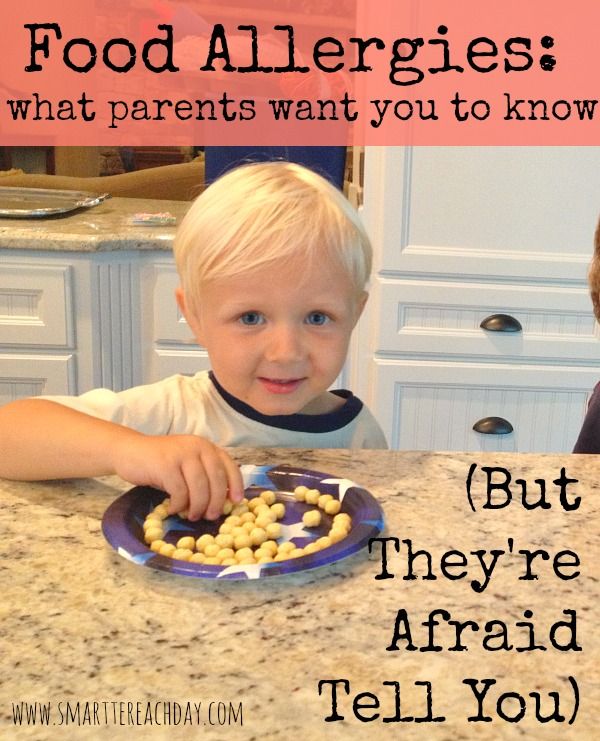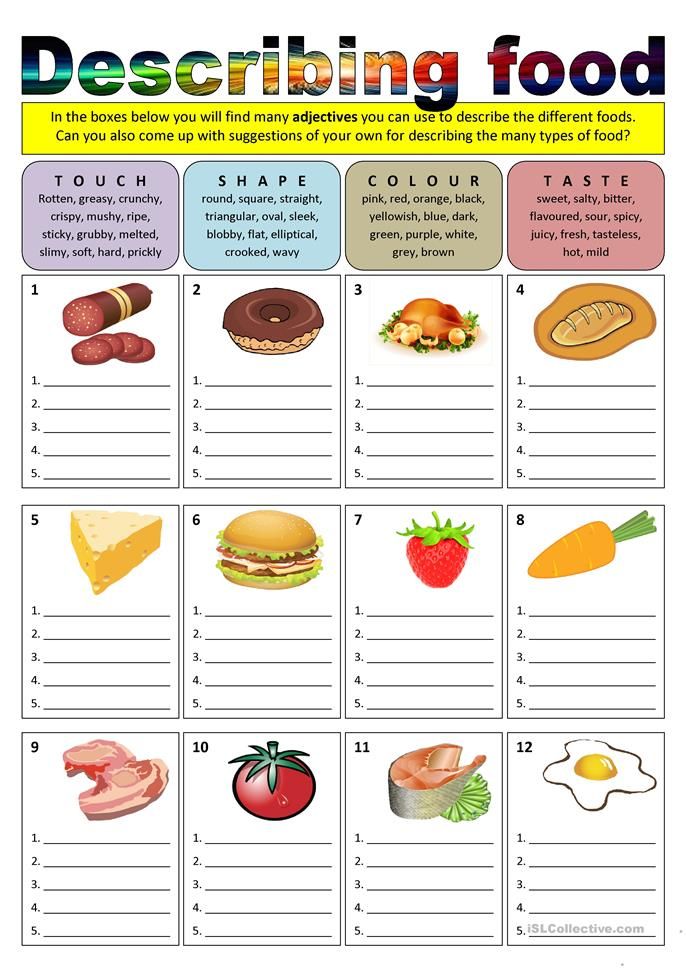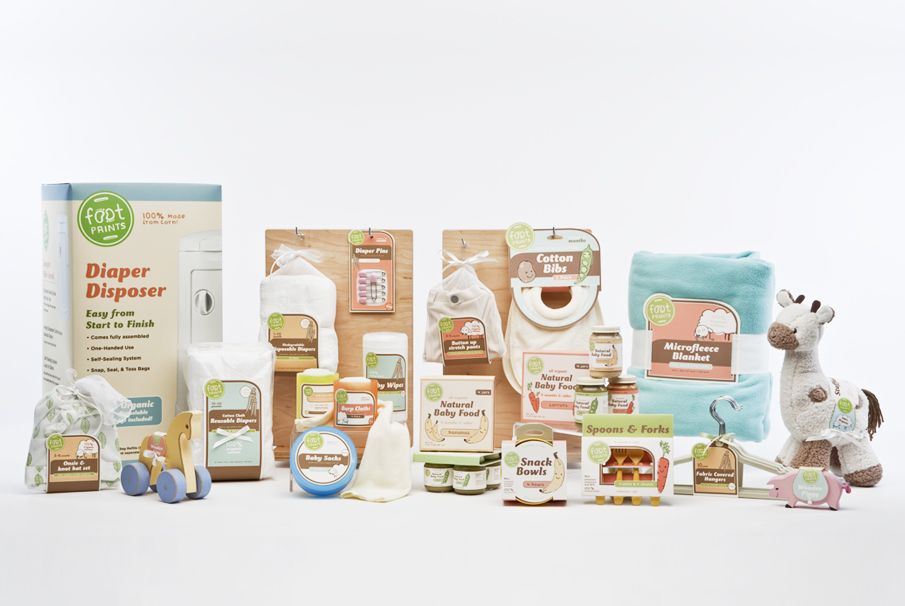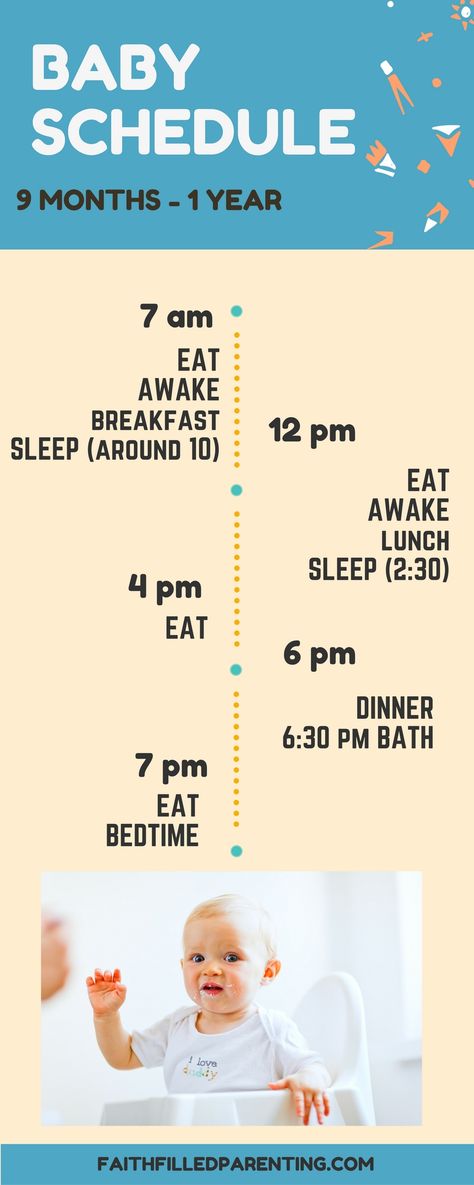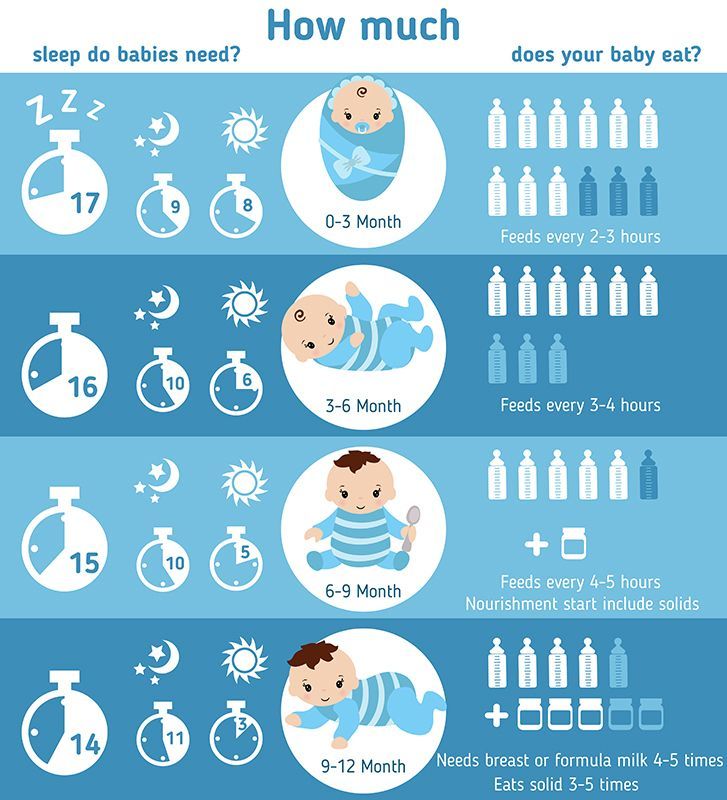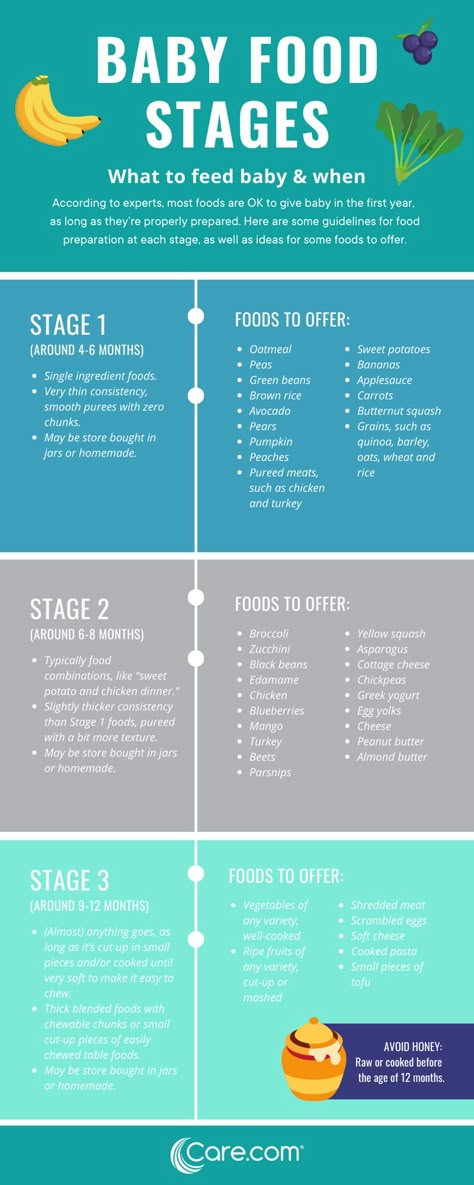Baby having allergic reaction to food
Baby Allergic Reaction to Food: Signs and Symptoms
Introducing your baby to solid foods can be such a fun and exciting time. But if you suspect your little one may have allergies, you might be worried about potential reactions — and for good reason!
Food allergies affect up to 8 percent of children in the United States.
While a family history of food allergies and similar conditions may be a clue that your baby will have allergies as well, it’s not always the best predictor.
Here’s how to get familiar with what a reaction looks like, learn how to spot a severe reaction, and understand the steps you’ll need to take to get your baby help.
Anaphylaxis is a severe allergic reaction that can be life threatening. If you suspect your baby may be having a serious reaction, call 911 or head to the nearest emergency room.
Symptoms may include:
- mood changes, including crankiness or inconsolability
- vomiting
- loose stools
- full-body rash or hives
- swelling (angioedema) of the eyes, lips, or elsewhere
- rapid heart rate (tachycardia)
- difficulty breathing or shortness of breath
- wheezing
- lethargy
- dizziness or fainting
- scratching the skin
Researchers share that babies tend to have hives, wheezing, and vomiting more than other symptoms.
One of the features of anaphylaxis versus a mild reaction is that it may come on quickly — think 5 to 30 minutes — after exposure. Recognizing these signs in your baby is the most important step to getting help.
So, what exactly is an allergic reaction? Well, if your baby is exposed to a substance — like a food or beverage — that they’re allergic to, a reaction is their body’s way of defending itself.
When exposed to an allergen, the body releases histamines that cause inflammation. As a result, your baby may have anything from mild to moderate or even severe symptoms.
Mild or moderate allergic reactions can happen after your baby touches, swallows, tastes, eats, or breathes in something they’re allergic to.
Symptoms might include:
- tingling or itchiness of the throat and mouth
- swelling in the lips, eyes, or face
- hives or rash
- eczema
- abdominal pain or vomiting
- congestion, sneezing, or runny nose
- dry cough
Even exposure to a tiny amount of a food they’re allergic to, like a piece of a peanut, can be enough to produce a reaction in some babies.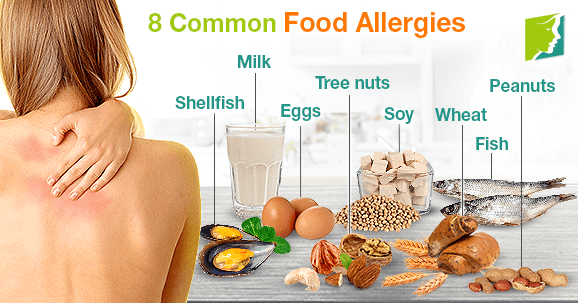
Of course, babies drool, spit up, and cry relatively often. They also don’t have the verbal skills to tell you something is wrong. Your baby may try to communicate that they’re not feeling well in some other way.
Pay close attention to your baby to spot these other possible signs of reaction:
- scratching or pulling at their tongue
- putting their hands in their mouth (in a way not typical for them)
- having a hoarse or squeaky voice
- pulling at their ears
- unusual crying or behavior
- any slurring in speech (if they’re already talking)
Again, one of the key features of a severe reaction versus a mild one is that it comes on soon after exposure.
Signs of anaphylaxis in babies tend to be milder than in older children and adults. The most reported symptoms of severe allergic reaction in babies are hives and vomiting.
In a 2018 study on 357 children ranging from infants to school-aged kids, researchers discovered that babies who have allergic reactions tend to have stomach issues 89 percent of the time.
Specifically, vomiting was present in 83 percent of severe reactions to foods. And a whopping 94 percent of babies experienced hives as part of their severe reaction versus just 62 percent of school-aged kids.
Only 17 percent of infants had breathing difficulties. In fact, just a single baby had wheezing.
And only one baby had low blood pressure as a result of their severe reaction, which is a hallmark sign of anaphylaxis in older children and adults.
That all said, it’s important to be able to identify any allergy signs in your little one, especially soon after consuming certain foods.
If your child has any of these signs, don’t hesitate to call 911 and get help. Even if you aren’t sure, it’s better to be safe than sorry.
Depending on the severity of the reaction, you’ll want to act fast to get your baby help — especially if this is their first reaction.
In particular, you’ll want to get emergency help (call 911) if your baby has:
- shortness of breath
- difficulty swallowing
- coughing
- a weak pulse
Combinations of other symptoms are also important to spot, like rash or swelling along with loose stools and vomiting.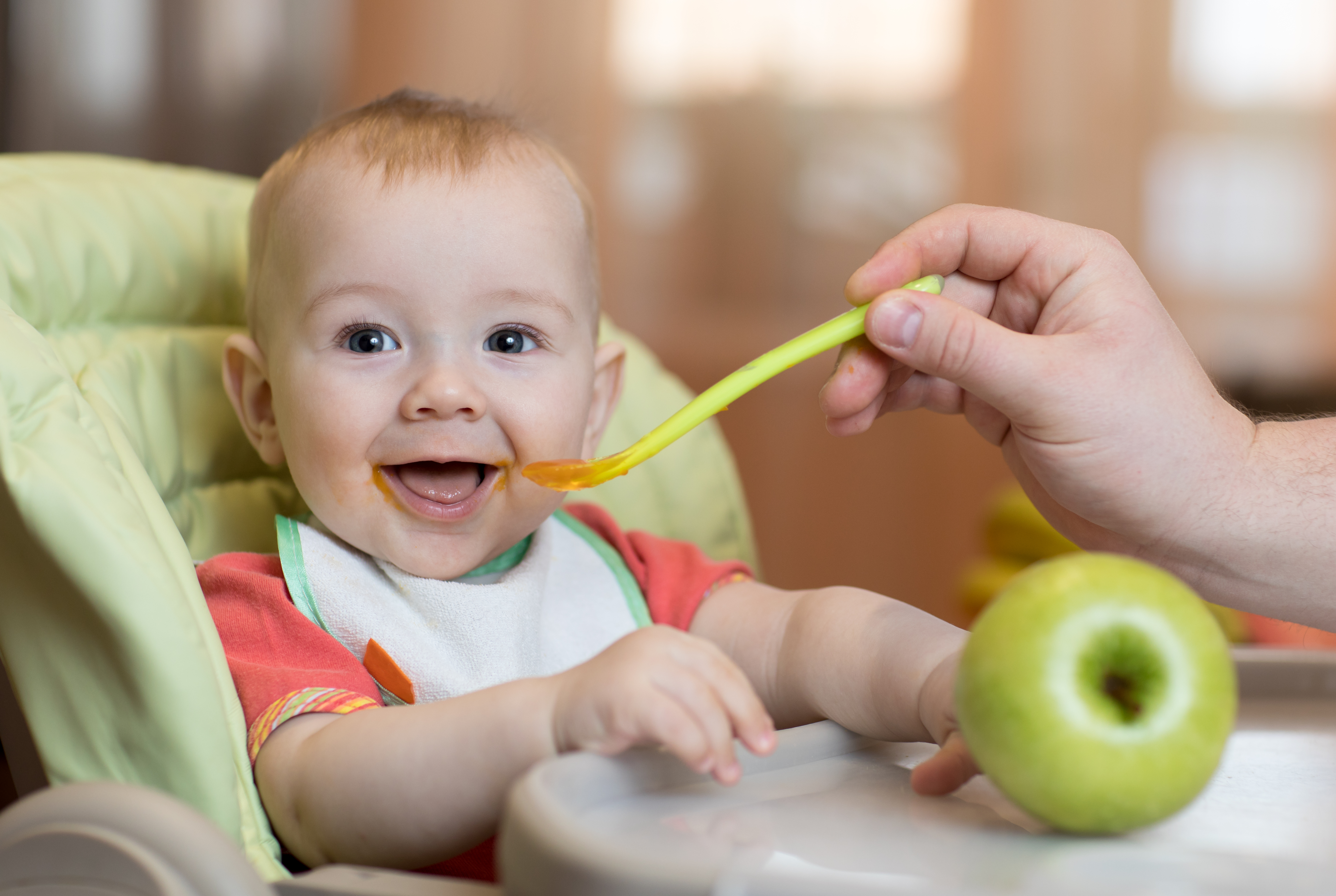
If you’ve dealt with reactions before, your doctor likely prescribed an epinephrine pen (EpiPen) to use in cases of severe reactions.
Use this drug as directed, then call an ambulance or drive to the ER. Either way, be ready to do CPR if your baby stops breathing at any time.
Once medical staff arrive, let them know that you’ve administered epinephrine. You may need to give another dose of the drug if symptoms return.
If your baby does have a severe reaction, it’s important to keep an eye on them for 6 to 8 hours after treatment. That’s because there’s risk of rebound anaphylaxis (severe symptoms that recur), typically within 8 hours of the initial reaction in up to 20 percent of cases.
If your little one has a mild reaction, it’s a good idea to call and check in with their pediatrician.
They can tell you if there are any steps you should take or if your baby needs an appointment. The doctor may also order allergy testing so you can identify other possible allergens to avoid.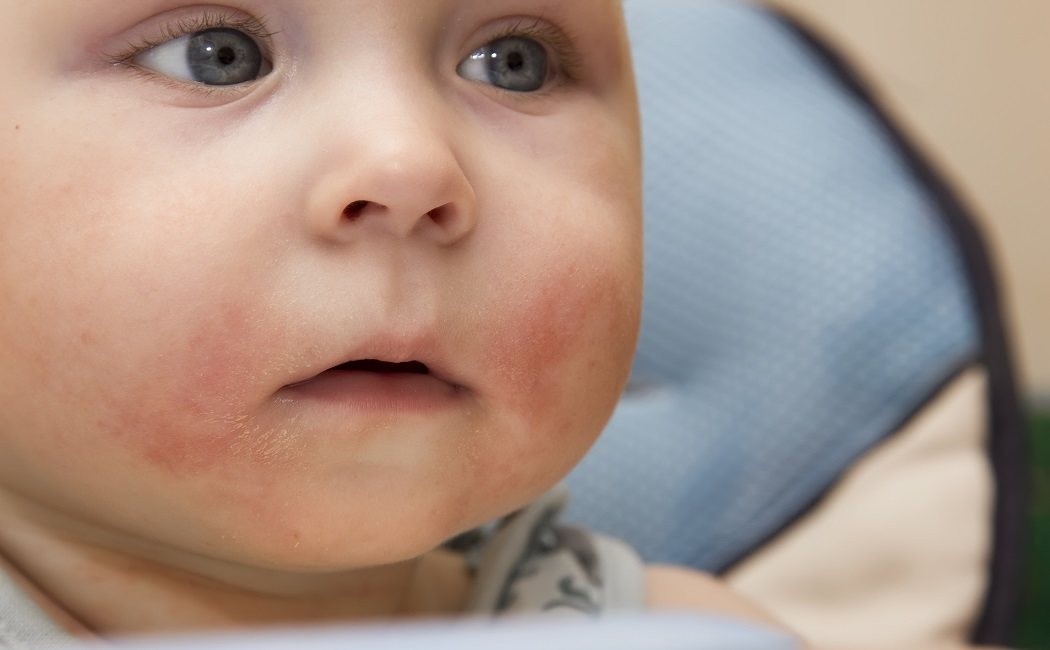
Related: What to expect when your baby has allergies
Most severe allergic reactions to foods will happen very soon after exposure. However, some milder reactions may take up to a few hours (usually around 2 hours) to become apparent.
Food allergies may be more common in families with a history of allergies and associated conditions, like asthma, eczema, or even hay fever.
The great majority of food-related allergic reactions are caused by one of the following:
- nuts (tree nuts and/or peanuts)
- fish
- shellfish
- eggs
- milk
- wheat
- soy
Of all foods, babies are most likely to be allergic to:
- milk
- eggs
- peanuts.
Though less common, some babies may be allergic to:
- certain fruits
- vegetables
- legumes (beans, peas, lentils, etc.)
Babies and children can “outgrow” their allergies over time, though allergies to peanuts, tree nuts, fish, and shellfish may be lifelong.
Experts recommend exposing babies to high-risk foods before they reach their first birthdays. Research from 2015 supports the idea that earlier exposure to peanuts, for example, may lower the risk of developing a peanut allergy later on.
So, for example, you’ll want to cook eggs and prepare peanuts in age-appropriate ways (fully cooked eggs, smooth peanut butter) and offer them up to twice per week.
How to do it:
- Try first rubbing a very small amount of an allergenic food on your child’s lips to observe any signs of reaction. (Remember: It can take minutes to hours for a reaction to occur.)
- If all looks good, add around a quarter teaspoon of the allergenic food to your baby’s usual puree and mix well.
- Over time, increase the amount of the allergenic food (by another quarter teaspoon) if you don’t observe an allergic reaction.
- Don’t rub foods into your baby’s skin. It doesn’t help with identifying allergies — and it might actually increase the risk of your baby developing an allergy to that particular food.

If you have a family history of food allergies, speak with your doctor about early introduction to certain foods. Some pediatricians may suggest you give the food under medical supervision in case of a severe reaction.
Related: How to safely introduce your baby to peanuts and other food allergens
The tricky thing with food allergies is that your baby’s reaction may not always be the same severity. Allergy experts explain that food that causes a relatively mild reaction one time may cause a more severe reaction another time.
Unfortunately, there’s no specific drug or supplement you can take to prevent or treat food allergies as a whole.
Instead, the goal is to avoid foods that cause reaction and have emergency treatment available in the event that baby has been exposed.
Some tips for avoiding allergenic foods:
- Read labels carefully. All the main food allergens should be listed in bold letters after the ingredients list for easy identification.
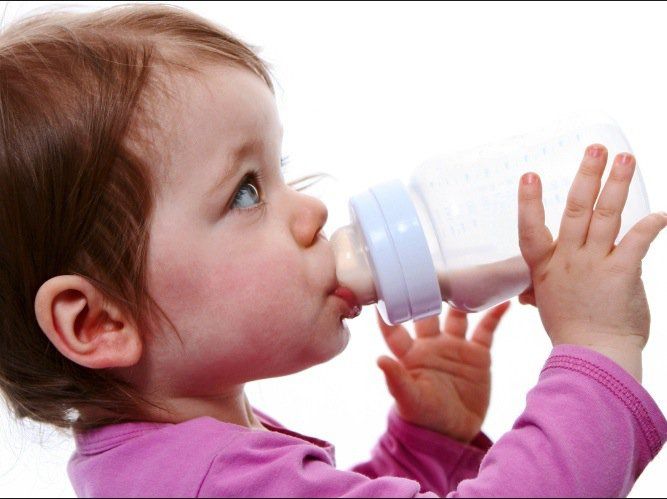 If ingredients aren’t listed, try asking staff or skipping the food entirely.
If ingredients aren’t listed, try asking staff or skipping the food entirely. - Note that some labels might say “may contain” or “made on shared equipment” for certain ingredients. This type of labeling isn’t well regulated. Speak with a doctor or allergist if you have concerns about your baby eating these foods.
- Have your child tested over time to see if they’ve outgrown their allergy. This is a more likely scenario with allergies to milk, eggs, wheat, and soy than it is with peanuts, tree nuts, shellfish, and fish.
- Consider reaching out to a dietitian or nutritionist for help if you feel your baby’s allergy is restricting their diet. A food expert can help you make sure your little one gets the nutrients they need to thrive, all while being safe.
- Look into getting a chef card. You can take it to restaurants to inform staff of your child’s specific allergy concerns. Cards are available in several different languages.
What about breastfeeding?
There’s no current evidence to support a restrictive diet while breastfeeding to prevent allergies in babies.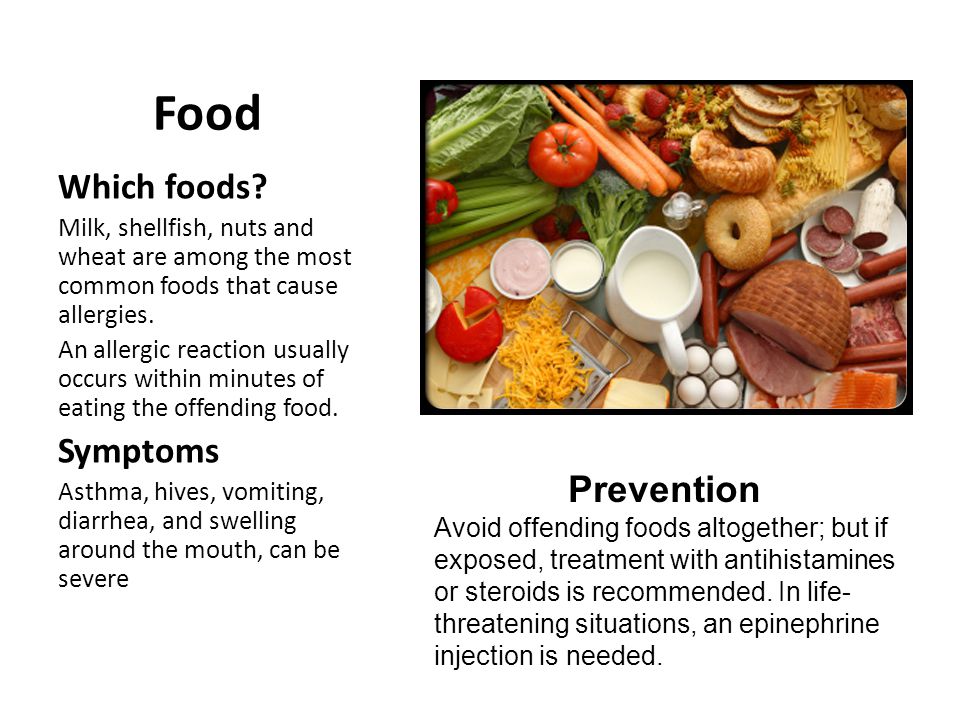 Instead, work with a doctor for guidance on dietary changes only after your baby shows a potential reaction to a food.
Instead, work with a doctor for guidance on dietary changes only after your baby shows a potential reaction to a food.
The proteins from food reach breast milk approximately 3 to 6 hours after consumption. After eliminating allergenic foods, it may take between 1 and 2 weeks for your baby’s allergy symptoms to subside.
Speak with your baby’s pediatrician if you have any concerns about giving allergenic foods to your child. Your doctor should have the most up-to-date information about how to prepare and introduce these foods in the safest way possible.
Your child’s doctor can also help you get appropriate allergy testing if needed and develop a plan for cases of severe reaction so you’ll feel more confident in an emergency.
Baby Allergic Reaction to Food: Signs and Symptoms
Introducing your baby to solid foods can be such a fun and exciting time. But if you suspect your little one may have allergies, you might be worried about potential reactions — and for good reason!
Food allergies affect up to 8 percent of children in the United States.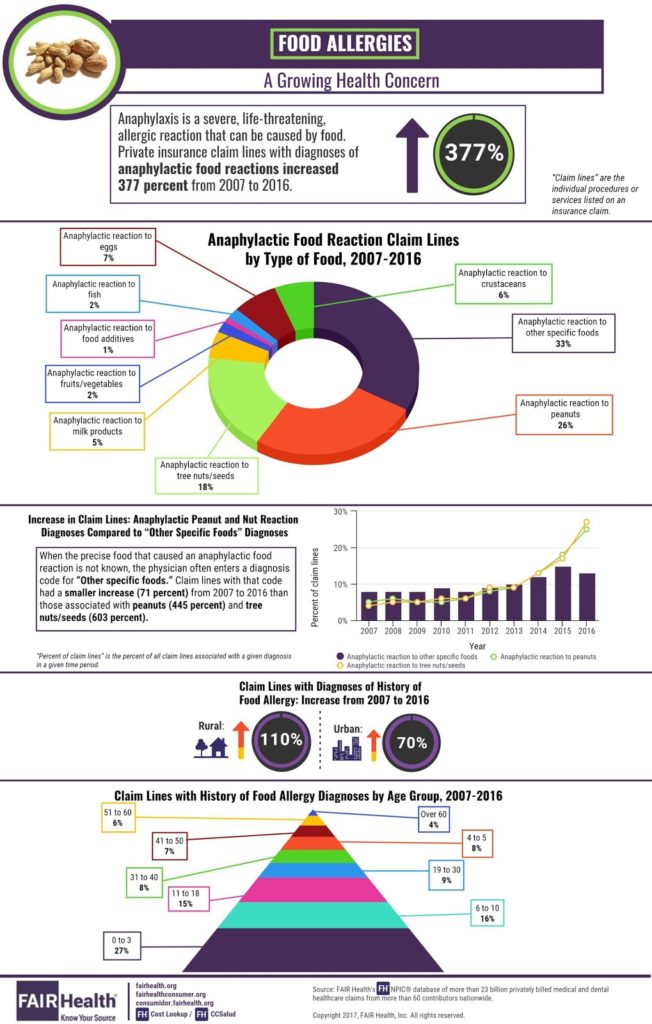
While a family history of food allergies and similar conditions may be a clue that your baby will have allergies as well, it’s not always the best predictor.
Here’s how to get familiar with what a reaction looks like, learn how to spot a severe reaction, and understand the steps you’ll need to take to get your baby help.
Anaphylaxis is a severe allergic reaction that can be life threatening. If you suspect your baby may be having a serious reaction, call 911 or head to the nearest emergency room.
Symptoms may include:
- mood changes, including crankiness or inconsolability
- vomiting
- loose stools
- full-body rash or hives
- swelling (angioedema) of the eyes, lips, or elsewhere
- rapid heart rate (tachycardia)
- difficulty breathing or shortness of breath
- wheezing
- lethargy
- dizziness or fainting
- scratching the skin
Researchers share that babies tend to have hives, wheezing, and vomiting more than other symptoms.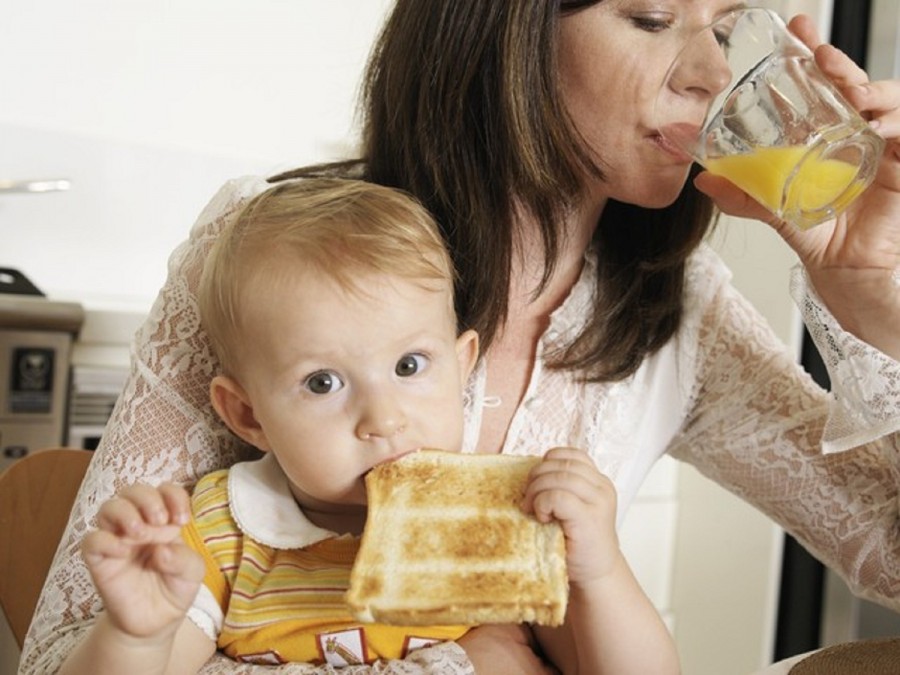
One of the features of anaphylaxis versus a mild reaction is that it may come on quickly — think 5 to 30 minutes — after exposure. Recognizing these signs in your baby is the most important step to getting help.
So, what exactly is an allergic reaction? Well, if your baby is exposed to a substance — like a food or beverage — that they’re allergic to, a reaction is their body’s way of defending itself.
When exposed to an allergen, the body releases histamines that cause inflammation. As a result, your baby may have anything from mild to moderate or even severe symptoms.
Mild or moderate allergic reactions can happen after your baby touches, swallows, tastes, eats, or breathes in something they’re allergic to.
Symptoms might include:
- tingling or itchiness of the throat and mouth
- swelling in the lips, eyes, or face
- hives or rash
- eczema
- abdominal pain or vomiting
- congestion, sneezing, or runny nose
- dry cough
Even exposure to a tiny amount of a food they’re allergic to, like a piece of a peanut, can be enough to produce a reaction in some babies.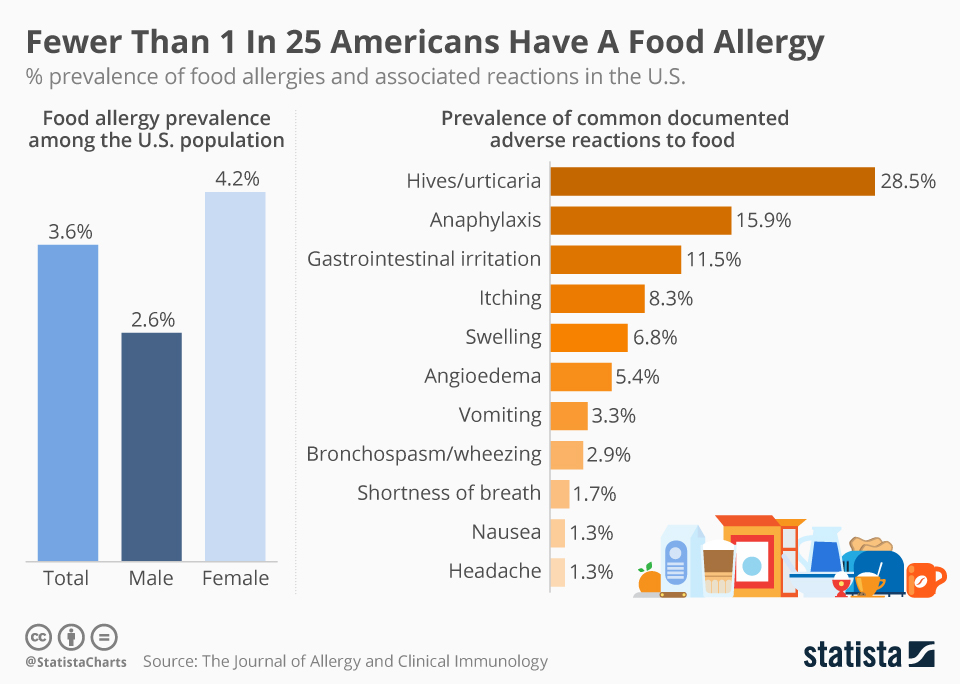
Of course, babies drool, spit up, and cry relatively often. They also don’t have the verbal skills to tell you something is wrong. Your baby may try to communicate that they’re not feeling well in some other way.
Pay close attention to your baby to spot these other possible signs of reaction:
- scratching or pulling at their tongue
- putting their hands in their mouth (in a way not typical for them)
- having a hoarse or squeaky voice
- pulling at their ears
- unusual crying or behavior
- any slurring in speech (if they’re already talking)
Again, one of the key features of a severe reaction versus a mild one is that it comes on soon after exposure.
Signs of anaphylaxis in babies tend to be milder than in older children and adults. The most reported symptoms of severe allergic reaction in babies are hives and vomiting.
In a 2018 study on 357 children ranging from infants to school-aged kids, researchers discovered that babies who have allergic reactions tend to have stomach issues 89 percent of the time.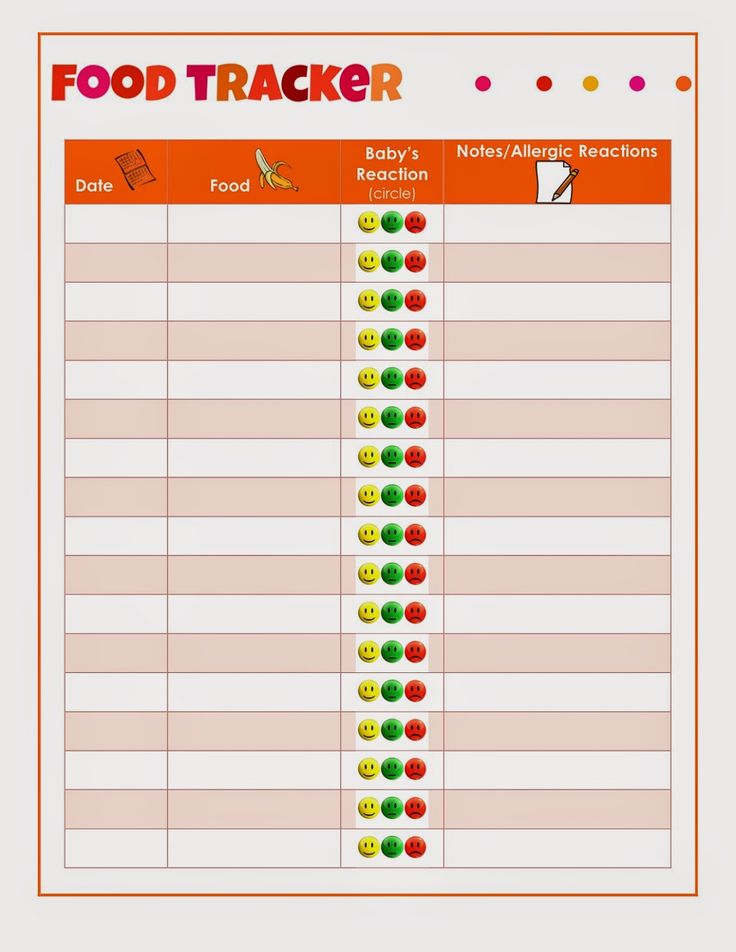
Specifically, vomiting was present in 83 percent of severe reactions to foods. And a whopping 94 percent of babies experienced hives as part of their severe reaction versus just 62 percent of school-aged kids.
Only 17 percent of infants had breathing difficulties. In fact, just a single baby had wheezing.
And only one baby had low blood pressure as a result of their severe reaction, which is a hallmark sign of anaphylaxis in older children and adults.
That all said, it’s important to be able to identify any allergy signs in your little one, especially soon after consuming certain foods.
If your child has any of these signs, don’t hesitate to call 911 and get help. Even if you aren’t sure, it’s better to be safe than sorry.
Depending on the severity of the reaction, you’ll want to act fast to get your baby help — especially if this is their first reaction.
In particular, you’ll want to get emergency help (call 911) if your baby has:
- shortness of breath
- difficulty swallowing
- coughing
- a weak pulse
Combinations of other symptoms are also important to spot, like rash or swelling along with loose stools and vomiting.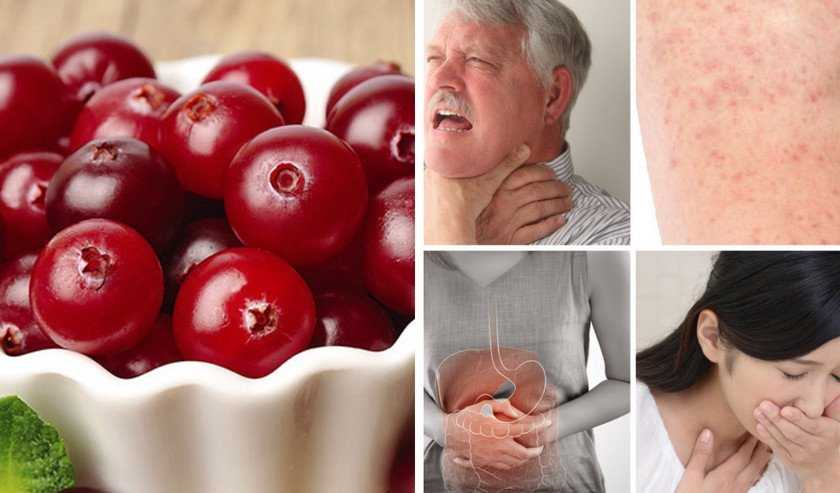
If you’ve dealt with reactions before, your doctor likely prescribed an epinephrine pen (EpiPen) to use in cases of severe reactions.
Use this drug as directed, then call an ambulance or drive to the ER. Either way, be ready to do CPR if your baby stops breathing at any time.
Once medical staff arrive, let them know that you’ve administered epinephrine. You may need to give another dose of the drug if symptoms return.
If your baby does have a severe reaction, it’s important to keep an eye on them for 6 to 8 hours after treatment. That’s because there’s risk of rebound anaphylaxis (severe symptoms that recur), typically within 8 hours of the initial reaction in up to 20 percent of cases.
If your little one has a mild reaction, it’s a good idea to call and check in with their pediatrician.
They can tell you if there are any steps you should take or if your baby needs an appointment. The doctor may also order allergy testing so you can identify other possible allergens to avoid.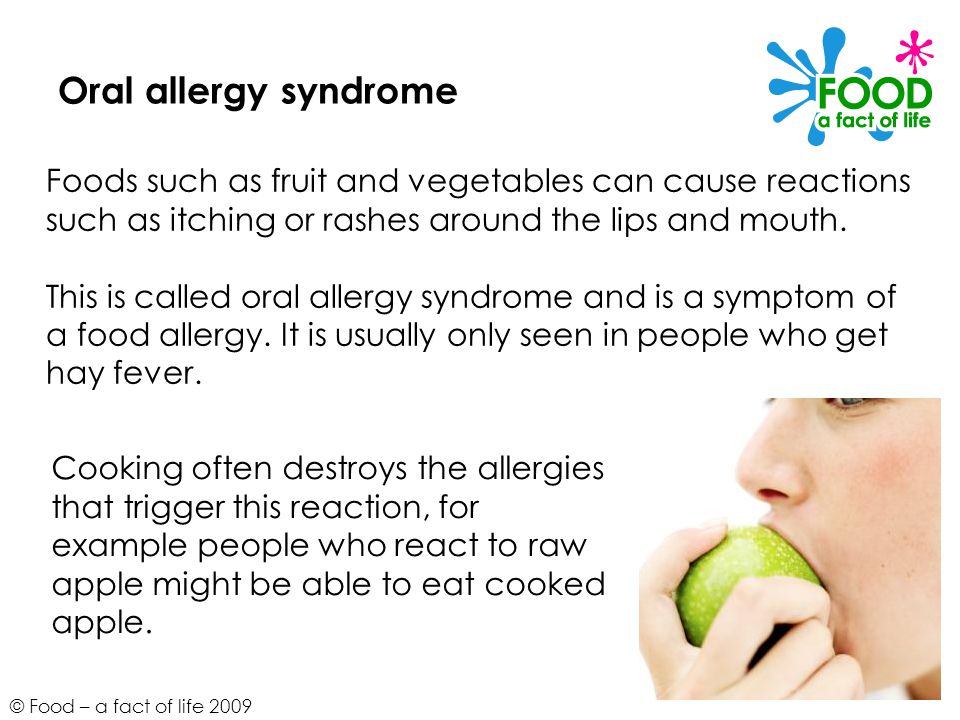
Related: What to expect when your baby has allergies
Most severe allergic reactions to foods will happen very soon after exposure. However, some milder reactions may take up to a few hours (usually around 2 hours) to become apparent.
Food allergies may be more common in families with a history of allergies and associated conditions, like asthma, eczema, or even hay fever.
The great majority of food-related allergic reactions are caused by one of the following:
- nuts (tree nuts and/or peanuts)
- fish
- shellfish
- eggs
- milk
- wheat
- soy
Of all foods, babies are most likely to be allergic to:
- milk
- eggs
- peanuts.
Though less common, some babies may be allergic to:
- certain fruits
- vegetables
- legumes (beans, peas, lentils, etc.)
Babies and children can “outgrow” their allergies over time, though allergies to peanuts, tree nuts, fish, and shellfish may be lifelong.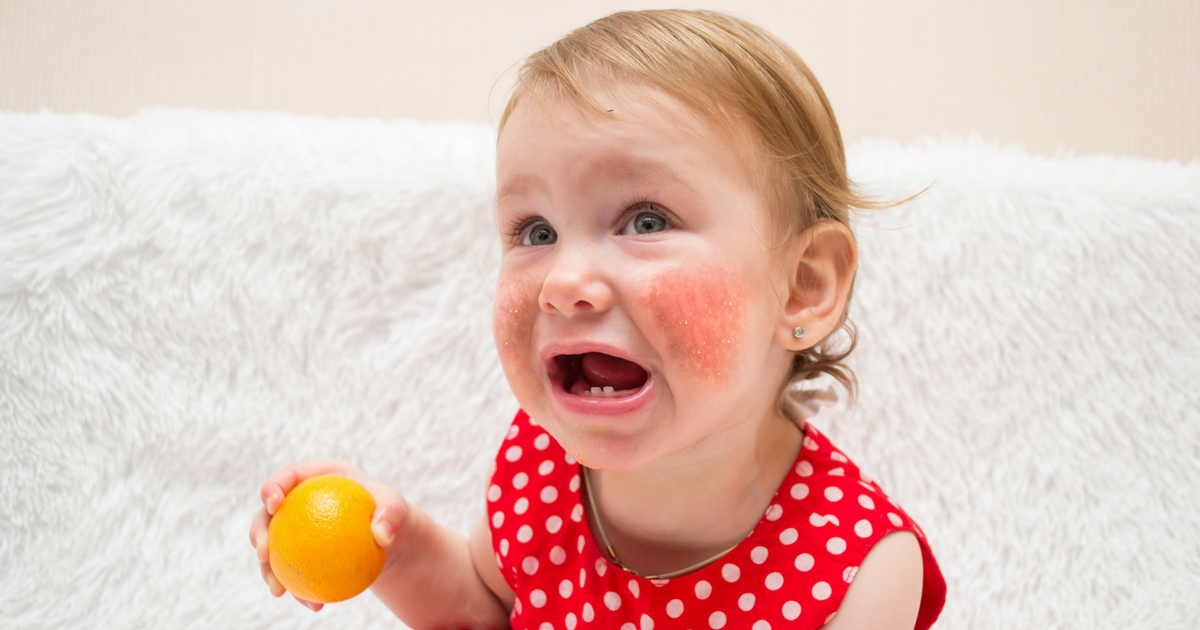
Experts recommend exposing babies to high-risk foods before they reach their first birthdays. Research from 2015 supports the idea that earlier exposure to peanuts, for example, may lower the risk of developing a peanut allergy later on.
So, for example, you’ll want to cook eggs and prepare peanuts in age-appropriate ways (fully cooked eggs, smooth peanut butter) and offer them up to twice per week.
How to do it:
- Try first rubbing a very small amount of an allergenic food on your child’s lips to observe any signs of reaction. (Remember: It can take minutes to hours for a reaction to occur.)
- If all looks good, add around a quarter teaspoon of the allergenic food to your baby’s usual puree and mix well.
- Over time, increase the amount of the allergenic food (by another quarter teaspoon) if you don’t observe an allergic reaction.
- Don’t rub foods into your baby’s skin. It doesn’t help with identifying allergies — and it might actually increase the risk of your baby developing an allergy to that particular food.
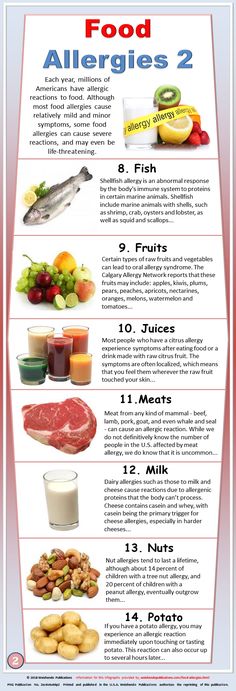
If you have a family history of food allergies, speak with your doctor about early introduction to certain foods. Some pediatricians may suggest you give the food under medical supervision in case of a severe reaction.
Related: How to safely introduce your baby to peanuts and other food allergens
The tricky thing with food allergies is that your baby’s reaction may not always be the same severity. Allergy experts explain that food that causes a relatively mild reaction one time may cause a more severe reaction another time.
Unfortunately, there’s no specific drug or supplement you can take to prevent or treat food allergies as a whole.
Instead, the goal is to avoid foods that cause reaction and have emergency treatment available in the event that baby has been exposed.
Some tips for avoiding allergenic foods:
- Read labels carefully. All the main food allergens should be listed in bold letters after the ingredients list for easy identification.
 If ingredients aren’t listed, try asking staff or skipping the food entirely.
If ingredients aren’t listed, try asking staff or skipping the food entirely. - Note that some labels might say “may contain” or “made on shared equipment” for certain ingredients. This type of labeling isn’t well regulated. Speak with a doctor or allergist if you have concerns about your baby eating these foods.
- Have your child tested over time to see if they’ve outgrown their allergy. This is a more likely scenario with allergies to milk, eggs, wheat, and soy than it is with peanuts, tree nuts, shellfish, and fish.
- Consider reaching out to a dietitian or nutritionist for help if you feel your baby’s allergy is restricting their diet. A food expert can help you make sure your little one gets the nutrients they need to thrive, all while being safe.
- Look into getting a chef card. You can take it to restaurants to inform staff of your child’s specific allergy concerns. Cards are available in several different languages.
What about breastfeeding?
There’s no current evidence to support a restrictive diet while breastfeeding to prevent allergies in babies.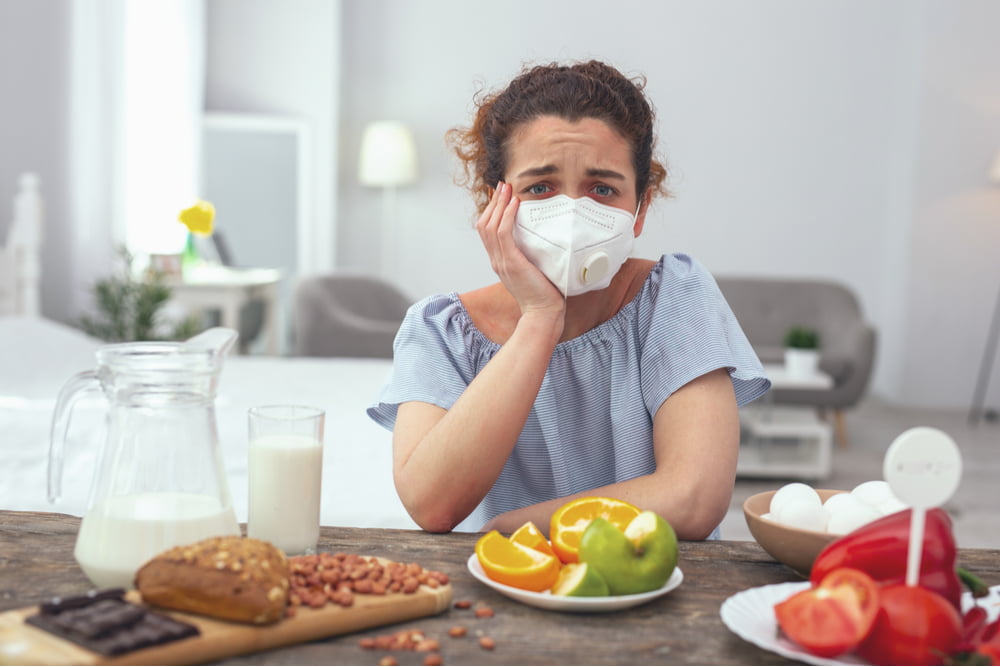 Instead, work with a doctor for guidance on dietary changes only after your baby shows a potential reaction to a food.
Instead, work with a doctor for guidance on dietary changes only after your baby shows a potential reaction to a food.
The proteins from food reach breast milk approximately 3 to 6 hours after consumption. After eliminating allergenic foods, it may take between 1 and 2 weeks for your baby’s allergy symptoms to subside.
Speak with your baby’s pediatrician if you have any concerns about giving allergenic foods to your child. Your doctor should have the most up-to-date information about how to prepare and introduce these foods in the safest way possible.
Your child’s doctor can also help you get appropriate allergy testing if needed and develop a plan for cases of severe reaction so you’ll feel more confident in an emergency.
Food allergy in children. How is it manifested and how to treat?
According to WHO, approximately 40% of the world's population has allergies in the 21st century. Mankind suffers from skin allergies, allergies to insect bites, to sunlight and cold.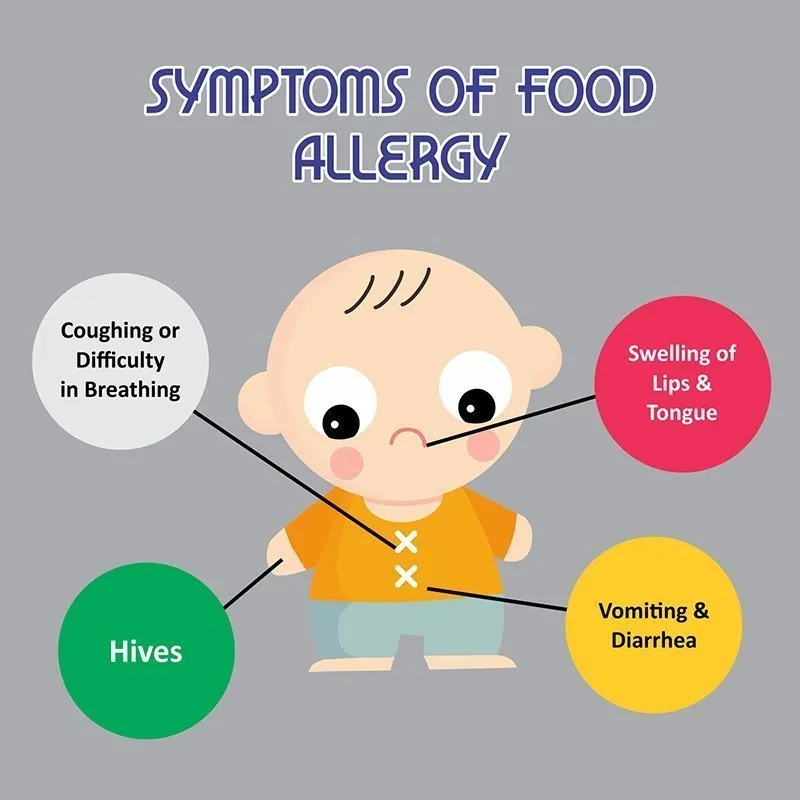 However, the “leader” of the rating is food allergies. And most of all, she worries children - both babies and older kids, and teenagers.
However, the “leader” of the rating is food allergies. And most of all, she worries children - both babies and older kids, and teenagers.
The disease only seems insignificant. She learned to "disguise" herself as other ailments, so not every parent is able to recognize her. How to get rid of allergies, we have already told. Today we will talk about food allergies. Why can one child eat everything without harm to health, while another completely harmless chocolate causes allergies?
What is a food allergy?
A child's food allergy is when the body reacts to one or more foods. During an allergy, the immune system accepts protein or other substances in food not as useful, but as very dangerous and harmful. Against the "enemy" immunity immediately builds protection by producing antibodies.
Each organism and immunity is individual, so it is very difficult to predict the child's reaction to the product. But some foods still cause a reaction more often than others.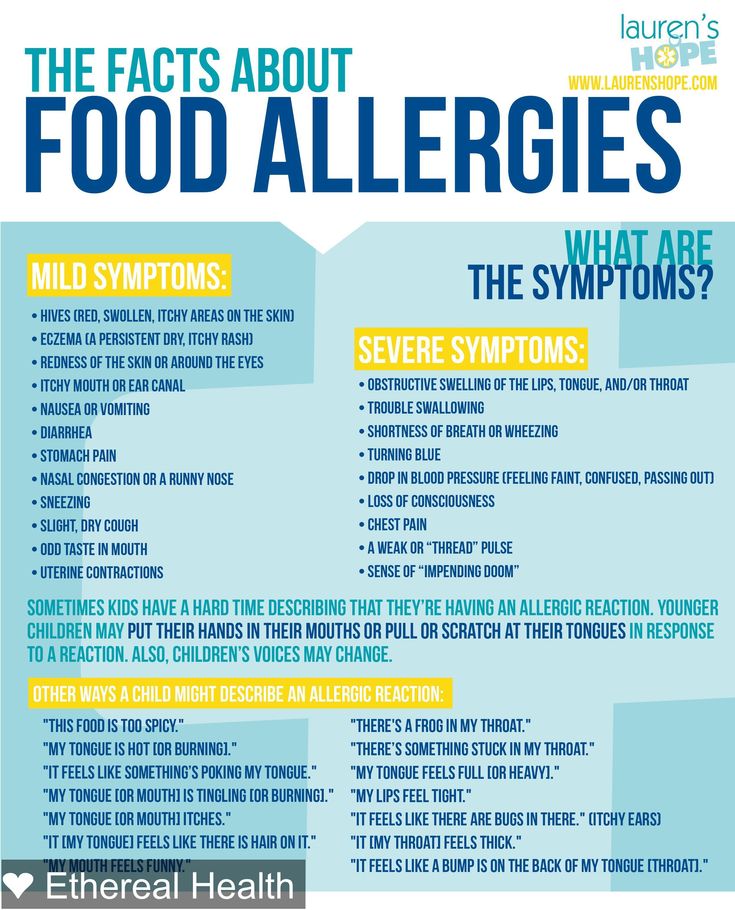
From citrus fruits to dried apricots and plums - high allergenic and low allergenic foods
Foods that cause allergies in a child are divided into highly allergenic, moderately allergenic and low allergenic foods. However, doctors remind: it is not at all necessary that oranges will cause a reaction, but pears will not. Each situation is purely individual.
How does food allergy manifest itself in children? 3 main symptoms
Food allergy manifests itself differently in children of different ages. But parents should know the general symptoms of the disease: the child does not want anything, is naughty, sleeps poorly and anxiously at night, and suffers from lack of sleep during the day.
At the same time, the disease also has its own characteristic alarming "signals". Some appear more frequently, others less frequently. What are the 3 main signs of food allergies in children.
Skin reaction
Most food allergies in children are indicated by redness.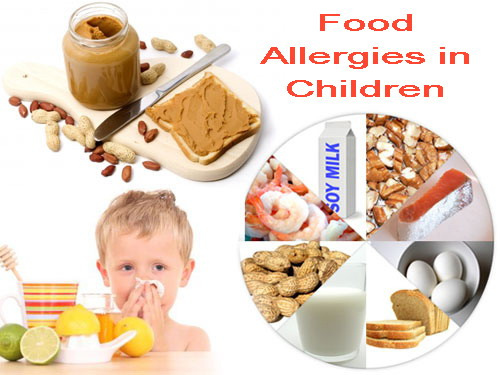 Pink dots, bubbles and red spots appear. The rash may continue with itching - from this the child sleeps and eats poorly.
Pink dots, bubbles and red spots appear. The rash may continue with itching - from this the child sleeps and eats poorly.
Respiratory system
Food allergy in children manifests itself in the respiratory system through a runny nose and nasal congestion, pain and sore throat, cough. With a strong reaction, edema appears. This is a reason to urgently call an ambulance.
Gastrointestinal
Allergy disrupts the child's stomach and intestines. The baby is worried about colic, bloating. Older children feel sick and vomit, there is pain in the abdomen.
Food allergy in children. Looking for causes
Why do children develop food allergies? There are several reasons for the appearance of allergic reactions.
1. Immaturity of the child's digestive system
In babies, everything is just starting to work, so it is difficult for the body to cope with digesting proteins. Even small amounts of allergens can lead to a serious reaction.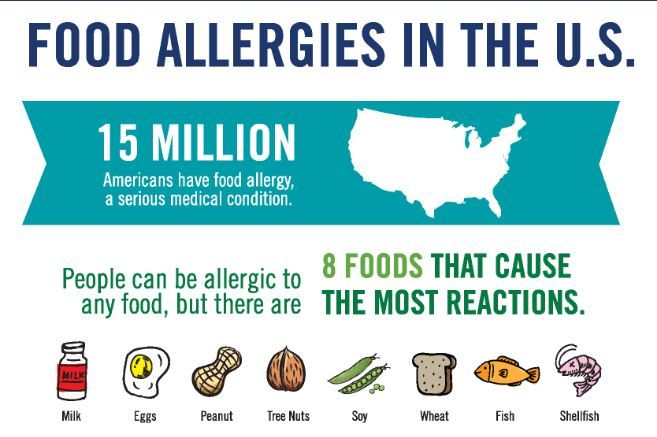
2. Irrational introduction of complementary foods
Incorrect or early introduction of new foods into the baby's diet can cause allergies. Too much food can also cause an adverse reaction in the body. Therefore, everything new should be given to the baby one at a time, starting with one teaspoon.
An allergy in an infant can manifest itself due to breast milk - if the mother has eaten a new or allergenic product the day before. But here, too, everything is individual.
3. Heredity
Food allergies in children sometimes manifest themselves due to unfavorable heredity. Parents suffer from allergies, and not necessarily food. The risk of developing this disease in a child increases significantly.
4. Ecology
Poor environmental ecology can also affect a child's allergies. These are air and air pollution, climate change, lack of landscaping in cities, the emergence of unnatural food and substitute products.
5. Bad habits
The risk of allergic reactions increases the presence of bad habits. We are talking about smoking, the use of alcohol or drugs, both by the child and the mother during gestation.
Treating food allergies
How to treat food allergies in a child? There are two types of therapy - diet and medication. The treatment program for each child is individual, it will be helped by a pediatrician and narrow specialists - a nutritionist and an allergist.
Diet
Diet is very important in treating a child's food allergy. First, it is necessary, of course, to limit the child from the use of products that cause allergic reactions. Parents should not forget that the diet should be balanced. No need to give up foods rich in vitamins and nutrients.
If we are talking about a child who is breastfed, the mother needs to think over the diet.
Complementary foods, as we mentioned earlier, should be started gradually.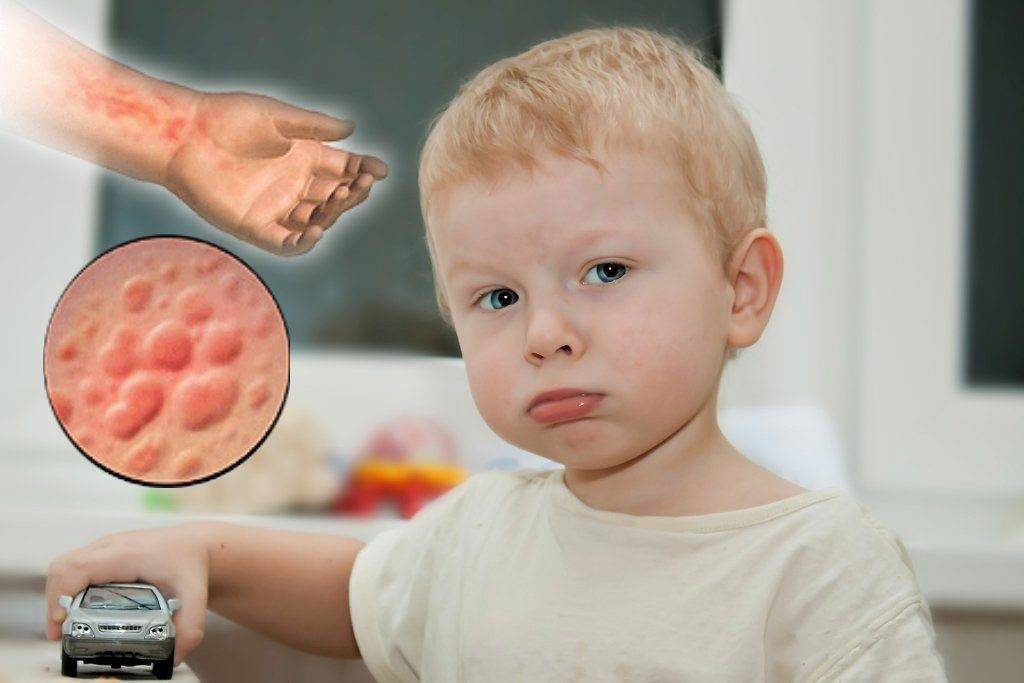 If a child suffers from allergies, then highly allergenic foods - cow's milk, nuts, chicken eggs - doctors advise giving the baby only when he is two years old.
If a child suffers from allergies, then highly allergenic foods - cow's milk, nuts, chicken eggs - doctors advise giving the baby only when he is two years old.
Medications
Doctors usually prescribe antihistamines and adsorbents to relieve food allergy symptoms in children. Creams and ointments will help get rid of redness and skin itching. Parents of the baby should strictly monitor the timely intake of medications and prevent an overdose of the drug.
Allergies can also be cured within the walls of a sanatorium. In the sanatorium "Mashuk Aqua-Therm" there is a special children's program Treatment of food allergies.
January 13, 2020 | allergy | children's programs
Food allergies in children - symptoms, treatment, diet
Food allergies in children or its individual components. What are its causes, what are the risk factors, and what food to choose in case of an allergic reaction - read in this material.
Food allergy symptoms
The causes of food intolerance are related to the fact that the immune system "incorrectly" recognizes them as potentially dangerous, and produces protective antibodies in excess.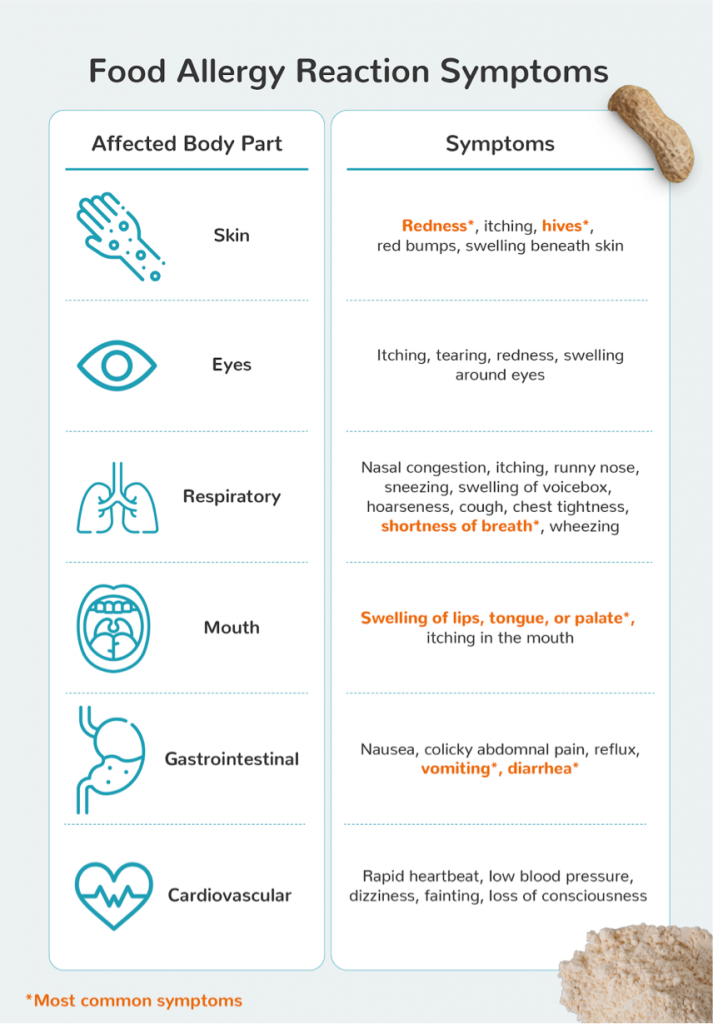 Excessively violent reaction leads to the fact that the child develops an allergy to certain types of food. 1.3
Excessively violent reaction leads to the fact that the child develops an allergy to certain types of food. 1.3
Symptoms of food allergy in children are different. But most often, food allergies manifest themselves on the part of the skin - itching, a feeling of tightness and dryness. Local swelling may occur on the skin, a rash (urticaria), redness, blisters may appear. In second place in terms of frequency of manifestation - reactions from the respiratory system. Runny nose, nasal congestion, sore throat, cough of varying intensity. Also, reactions from the organs of the gastrointestinal tract can indicate food allergies. A very young child begins to be disturbed by colic, dyspepsia, stool disorders from diarrhea to constipation. Older children complain of nausea, vomiting, abdominal pain, a feeling of scratching in the throat, behind the sternum.
Do not forget about the general symptoms of food allergies: the child becomes lethargic, capricious, sleeps poorly, does worse in school (or psycho-emotional development), is prone to daytime sleepiness. 2.3
2.3
Causes of food allergies
Newborns and young children, if predisposed, may suffer from allergies due to their physiological characteristics. The fact is that a child is born with an immature gastrointestinal tract, the intestinal walls are permeable to many substances, the enzyme system is still imperfect. Therefore, it is difficult for the body to cope with the digestion of proteins. The body seems to be in a state of constant "combat readiness" and the ingestion of even a small amount of allergens leads to a response from the immune system and the development of a violent allergic reaction. 1.2
In older children, many internal and external conditions become risk factors. For example, heredity - after all, if one of the child's parents suffered from an allergic disease, then with a high degree of probability the child will also be given a tendency to it. Unfavorable environmental factors influence - polluted atmosphere, car exhausts, lack of green plants in cities.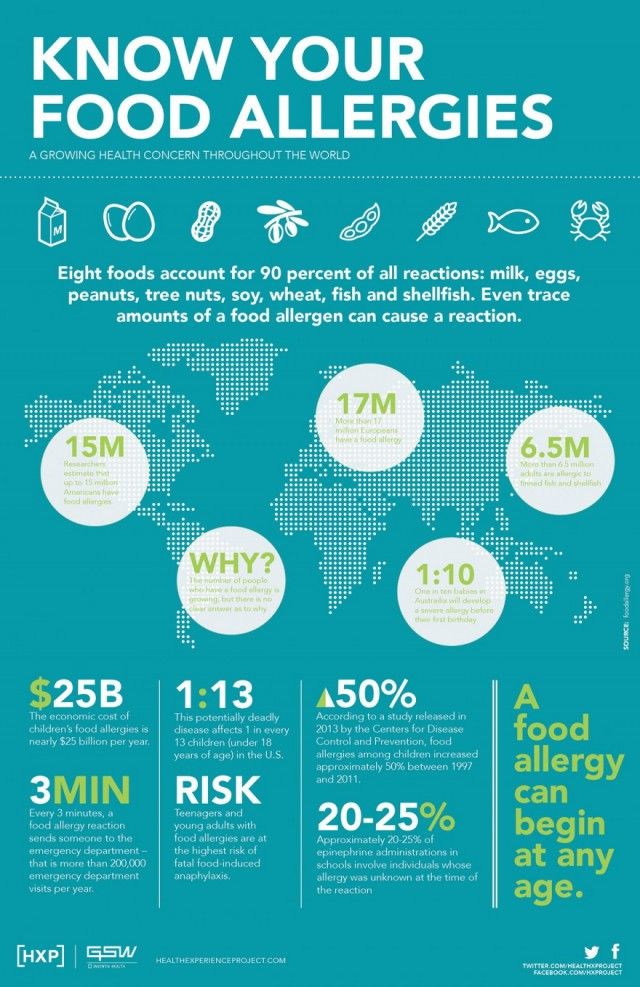 Very often, a violation of the immune system in the form of an allergic reaction occurs in children with a labile, mobile psyche, with sharp transitions from friendliness and calmness to crying and back. Finally, bad habits, both in children and mothers during pregnancy, become an important factor. This is incorrectly introduced complementary foods and early introduction of potentially allergenic foods into the child's diet: citrus fruits, nuts, chocolate, berries, honey, and, of course, the habit of children to eat only something tasty (usually unhealthy; chocolate, carbonated drinks, fast food ) 2,3,4
Very often, a violation of the immune system in the form of an allergic reaction occurs in children with a labile, mobile psyche, with sharp transitions from friendliness and calmness to crying and back. Finally, bad habits, both in children and mothers during pregnancy, become an important factor. This is incorrectly introduced complementary foods and early introduction of potentially allergenic foods into the child's diet: citrus fruits, nuts, chocolate, berries, honey, and, of course, the habit of children to eat only something tasty (usually unhealthy; chocolate, carbonated drinks, fast food ) 2,3,4
List of products that provoke allergies
Due to the extreme individuality of the immune system, it is almost impossible to predict its reaction. However, there is a rough list of foods classified into groups depending on their allergenicity - that is, the ability to cause a sharp reaction from the immune system and allergy symptoms. It is important to remember that it is not necessary that any product from the first column will cause a reaction.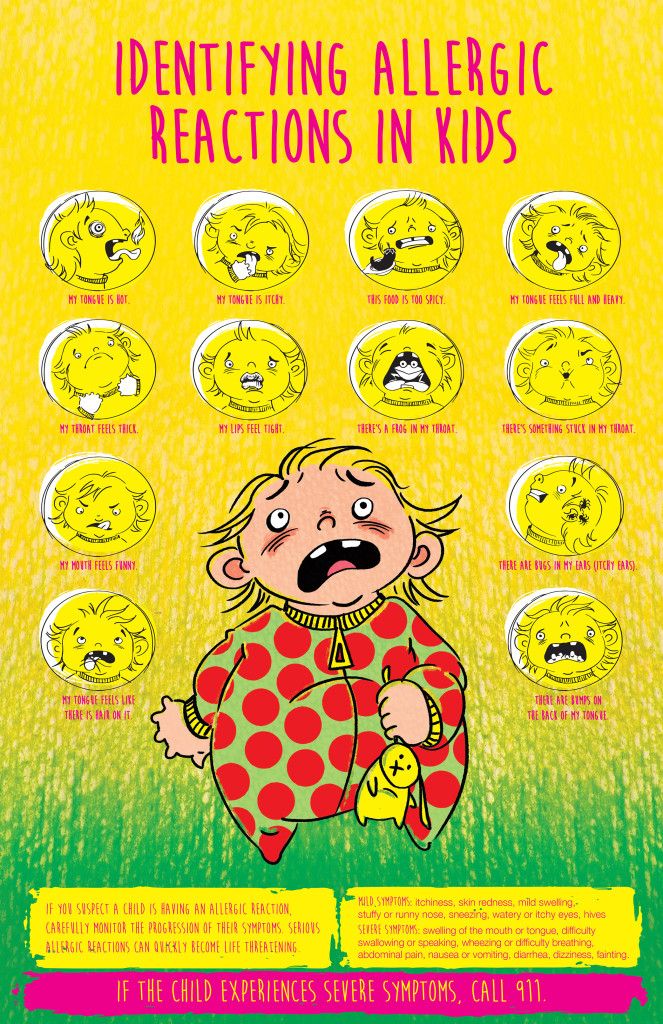 Like any low allergenic product, in some cases, it can cause an overreaction to it. 2,3,4
Like any low allergenic product, in some cases, it can cause an overreaction to it. 2,3,4
Examples of the most typical exoallergens
| Highly allergenic products | Foods of average allergenicity | Low Allergy Products | |
| all citrus fruits, strawberries, strawberries, raspberries, blackberries, pineapples. | peaches, cranberries, lingonberries, cherries, blueberries, black currants. | pears, gooseberries, dried apricots, plums, white currants, apples and pears. | |
| carrots, tomatoes, bell peppers, radishes. | potatoes, beets, peppers, peas, corn. | broccoli, green peas, zucchini, squash, white and cauliflower, cucumbers, pumpkin. | |
| eggs, sausages and sausages, chicken, sea fish. | beef, rabbit, pork. | lamb. | |
whole cow's milk, cheeses, yoghurts with additives.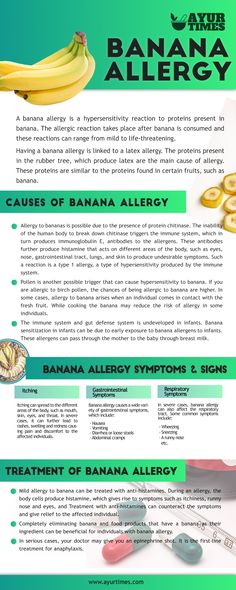 | fermented milk products. | ||
| wheat, rye. | buckwheat, oats, rice, peas, beans. | barley, millet. | |
| coffee, cocoa, chocolate, nuts, honey. | xylitol, fructose | ||
| mushrooms, carbonated drinks, packaged juices. | vegetable oil. |
Diagnosis established
The diagnosis of this allergy, as well as the search for the causes that caused it, requires a careful and serious approach on the part of parents. The younger the child, the easier it is to find foods that cause illness. For this, two conditions must be met.
The first thing is to put a child or mother on a hypoallergenic diet if she is breastfeeding - a detailed nutrition plan will be helped by an allergist together with a pediatrician. Please note that during an exacerbation, the diet will be extremely strict, the so-called elimination diet - aimed at removing the allergen and reaction products to it with the complete elimination of potential and cross allergens.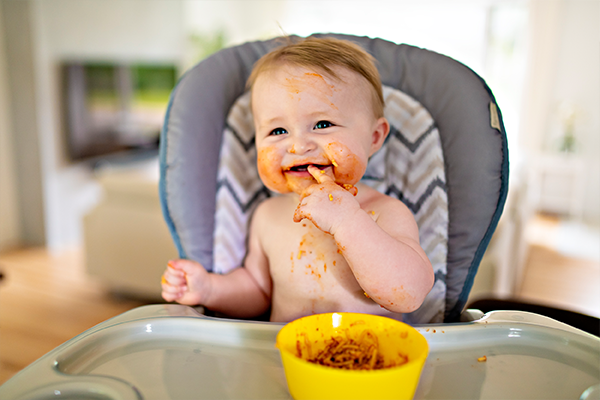 The duration of such a diet is determined by the doctor. When the exacerbation fades, the diet gradually expands due to safe foods. 3.4
The duration of such a diet is determined by the doctor. When the exacerbation fades, the diet gradually expands due to safe foods. 3.4
And the second thing is to start keeping a special food diary in which to record everything that was eaten and drunk by the child during the day, as well as what was prepared and how. At the first sign of an allergic reaction, suspicious foods should be eliminated one at a time (or from the mother's diet if the baby is breastfed). After elimination, within a few days, it is worth observing the reaction, if the manifestations of allergies decrease, then the product is really not suitable for the child - it should be avoided. If the child is very small, then the diary is kept according to the opposite principle: all foods that are introduced as complementary foods are recorded in it. The name of the product, the quantity, the time of eating and the reactions of the body are recorded over the next few days (the attending physician will determine the specific timing of observation).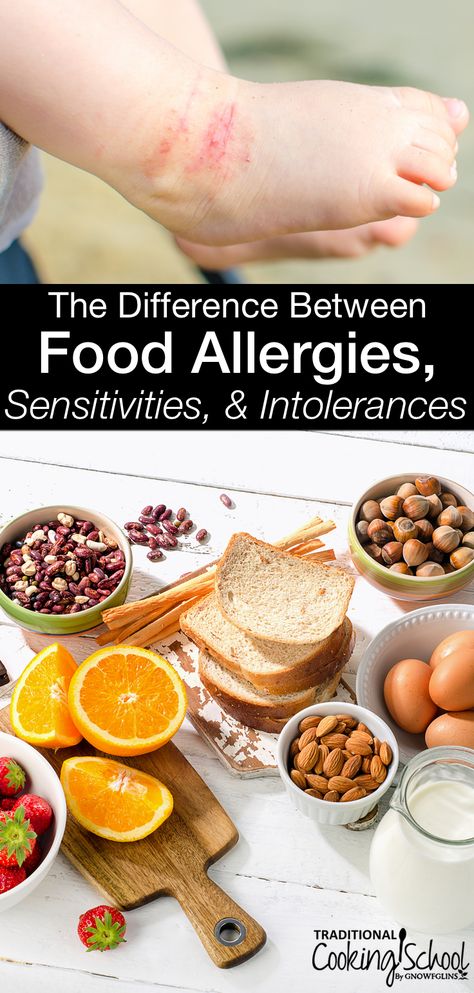 Next, the doctor will need to check and confirm the preliminary diagnosis by conducting special tests and analyzes.
Next, the doctor will need to check and confirm the preliminary diagnosis by conducting special tests and analyzes.
Emergency measures for food allergies
First, you need to assess the severity of the manifestations of food allergies.
For any symptoms, contact with a specific familiar allergen or any suspicious food or drink should be avoided first.
If the symptoms of allergy are mild - itching, redness of the skin, then you can give the child an antihistamine, which was previously recommended by the doctor for such cases. In addition, you must also call the local pediatrician and carefully monitor the condition of the child.
In case of obvious or possible signs of deterioration, call an ambulance. Signs that you should pay close attention to and immediately dial 03 include spreading rash and redness, increased itching, fever, drowsiness and lethargy, vomiting and nausea, refusal to drink water, difficulty breathing, loss of consciousness and pallor .